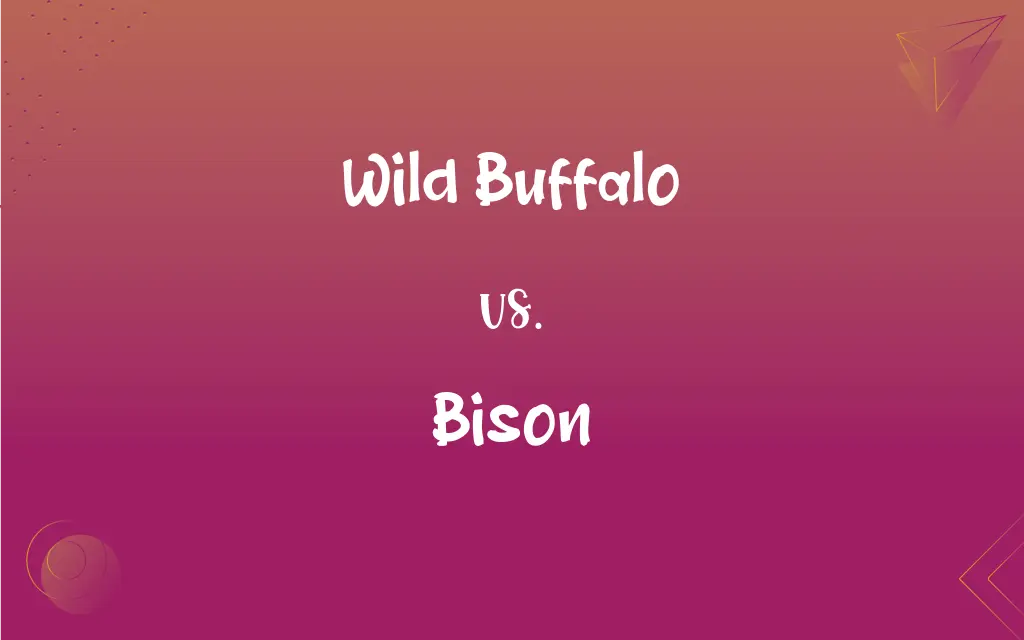Wild Buffalo vs. Bison: What's the Difference?
Edited by Aimie Carlson || By Janet White || Published on November 2, 2023
Wild buffalo are large bovines native to Asia and Africa, while bison are large bovines native to North America and Europe.

Key Differences
Wild buffalo, like the African Cape buffalo and the Asian water buffalo, thrive in different continents than the bison, primarily in Asia and Africa. Conversely, bison species, like the American bison, are indigenous to North America and Europe.
While both wild buffalo and bison belong to the Bovidae family, they come from different genera. Wild buffalo have the genus Syncerus or Bubalus, whereas bison belong to the genus Bison.
Physical differences set wild buffalo and bison apart. Wild buffalo often have larger, curvier horns and a different head shape compared to bison, which possess a more pronounced hump on their shoulders.
Their habitats differ too. Wild buffalo often dwell in wetlands, swamps, and grasslands, while bison predominantly reside in plains, prairies, and forests in North America.
When discussing conservation, some wild buffalo species like the water buffalo are domesticated extensively, while bison, particularly the American bison, faced near-extinction and have been part of conservation efforts.
ADVERTISEMENT
Comparison Chart
Native Regions
Asia and Africa
North America and Europe
Genera
Syncerus (African buffalo) and Bubalus (Asian water buffalo)
Bison
Physical Characteristics
Larger, curvier horns; different head shape
Pronounced shoulder hump
Habitat
Wetlands, swamps, grasslands
Plains, prairies, forests
Conservation Status
Some species domesticated; others are wild
Faced near-extinction; conservation efforts in place
ADVERTISEMENT
Wild Buffalo and Bison Definitions
Wild Buffalo
Animals with curved horns and sturdy build.
The wild buffalo charged at the predator with its massive horns.
Bison
Once faced near-extinction in the 19th century.
Conservation efforts have helped revive bison populations.
Wild Buffalo
Large bovines native to Asia and Africa.
The wild buffalo roamed the African savanna.
Bison
Large bovines native to North America and Europe.
The bison roamed the vast American plains.
Wild Buffalo
Often found in wetlands and grasslands.
Wild buffalo in Asia prefer marshy areas for wallowing.
Bison
Recognizable by their hump and thick fur.
The bison's fur coat helps it withstand cold winters.
Wild Buffalo
Some species are domesticated for various uses.
Many farmers in Asia rely on domesticated wild buffalo for plowing.
Bison
Herbivores primarily grazing on grasses.
The bison herd moved to a new grazing spot.
Wild Buffalo
Represents strength and power in various cultures.
The image of the wild buffalo stands as a symbol of bravery.
Bison
Hold cultural significance for indigenous peoples.
For Native Americans, the bison represents resilience and life.
Bison
A bovine mammal (Bison bison) of western North America, having large forequarters, a shaggy mane, and a massive head with short curved horns; a buffalo.
Bison
A bovine mammal (Bison bonasus) of Europe, similar to the American bison but with a somewhat smaller head and longer horns; a wisent.
Bison
The flesh of the American bison, used as food.
Bison
A large, wild bovid of the genus Bison.
Bison
The aurochs or European bison.
Bison
Any of several large shaggy-maned humped bovids having large heads and short horns
FAQs
Where are bison primarily found?
Bison are primarily native to North America and Europe.
Are wild buffalo domesticated?
Yes, some species of wild buffalo, like the Asian water buffalo, are domesticated.
What's a notable physical trait of bison?
Bison have a pronounced hump on their shoulders.
Which buffalo is known for its curvier horns?
The wild buffalo, especially the African Cape buffalo.
What's the habitat preference of bison in North America?
Bison predominantly reside in plains, prairies, and forests.
Do wild buffalo and bison belong to the same genus?
No, wild buffalo belong to genera like Syncerus or Bubalus, while bison belong to the genus Bison.
How are wild buffalo and bison used by humans?
Wild buffalo are often used for agriculture, while bison have been hunted for meat and hides.
How do wild buffalo handle threats?
Wild buffalo are known to charge at threats with their strong build and sharp horns.
What are wild buffalo?
Wild buffalo are large bovines native to Asia and Africa.
Do bison have a significance in Native American culture?
Yes, bison hold deep cultural and spiritual significance for many Native American tribes.
How many species of bison are there?
There are two main species: the American bison and the European bison.
Why were bison nearly extinct in the past?
Bison faced overhunting and habitat loss in the 19th century.
Are there efforts to conserve bison?
Yes, there have been significant conservation efforts to restore bison populations.
Are there bison in national parks?
Yes, places like Yellowstone National Park in the U.S. have wild bison populations.
Do wild buffalo have a social structure?
Yes, wild buffalo often live in herds and have a hierarchical structure.
What do bison eat?
Bison are herbivores, primarily grazing on grasses.
Can wild buffalo swim?
Yes, especially the Asian water buffalo, which often wallows and swims in marshy areas.
How fast can a bison run?
Bison can run at speeds up to 35 mph when threatened or provoked.
Do both animals belong to the Bovidae family?
Yes, both wild buffalo and bison belong to the Bovidae family.
Are wild buffalo found in North America?
No, wild buffalo are native to Asia and Africa.
About Author
Written by
Janet WhiteJanet White has been an esteemed writer and blogger for Difference Wiki. Holding a Master's degree in Science and Medical Journalism from the prestigious Boston University, she has consistently demonstrated her expertise and passion for her field. When she's not immersed in her work, Janet relishes her time exercising, delving into a good book, and cherishing moments with friends and family.
Edited by
Aimie CarlsonAimie Carlson, holding a master's degree in English literature, is a fervent English language enthusiast. She lends her writing talents to Difference Wiki, a prominent website that specializes in comparisons, offering readers insightful analyses that both captivate and inform.






































































